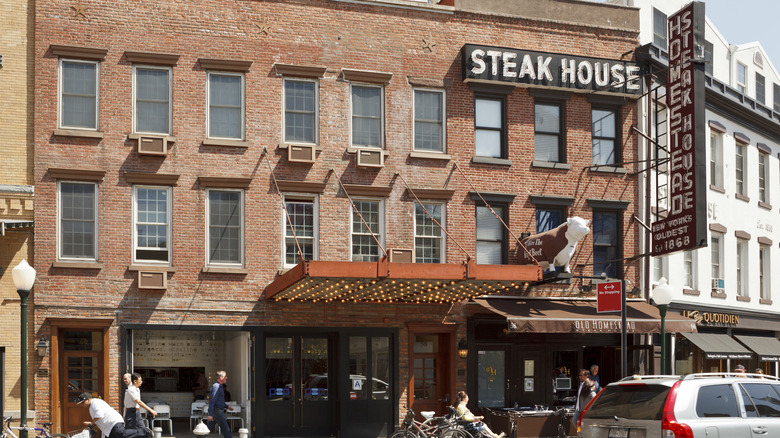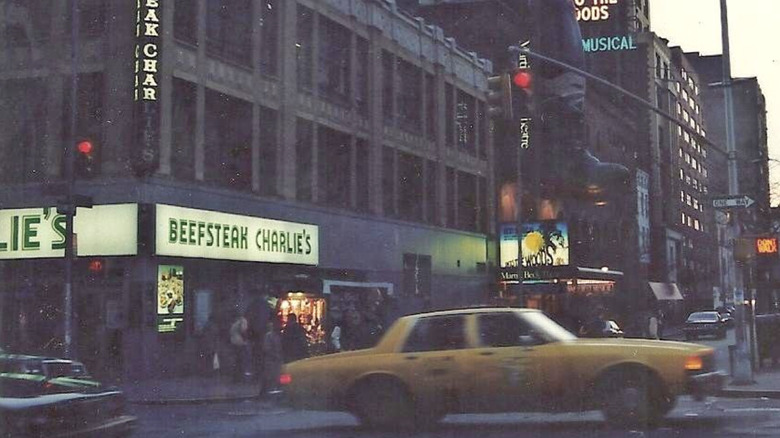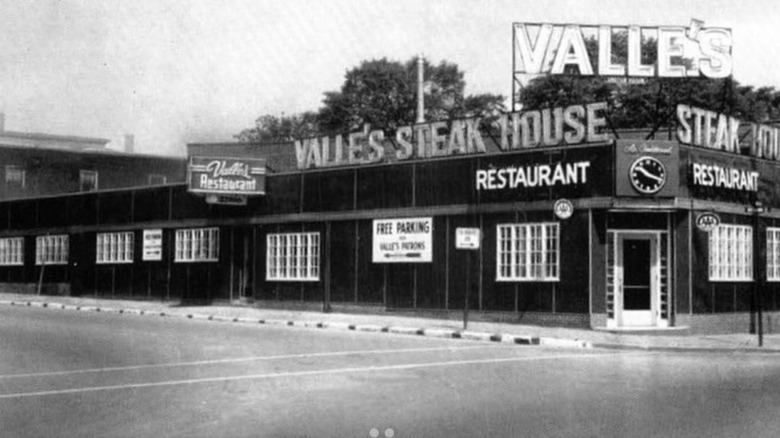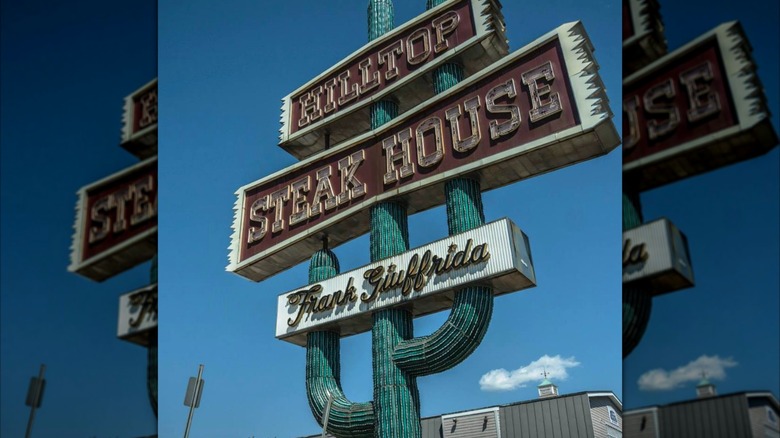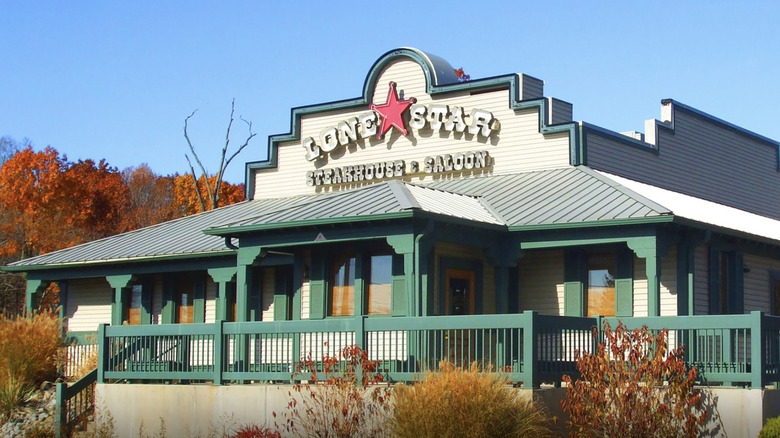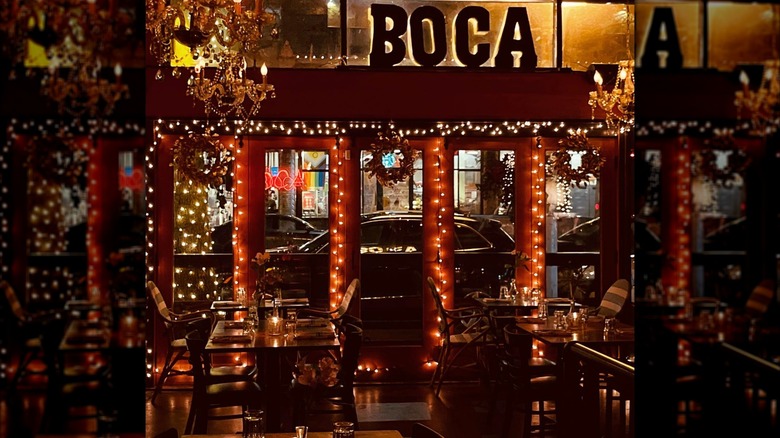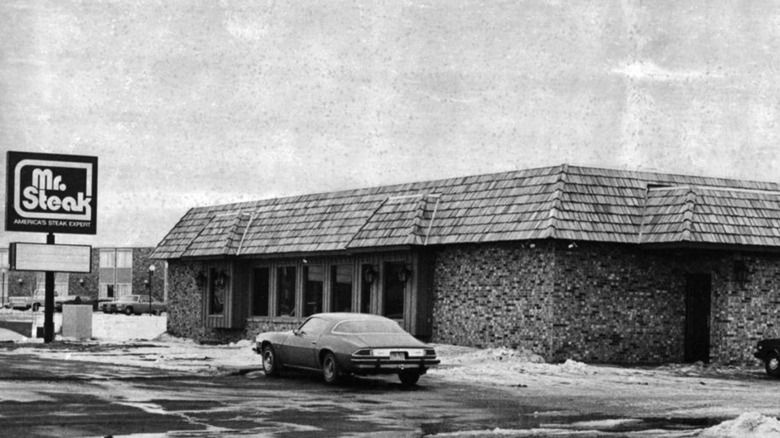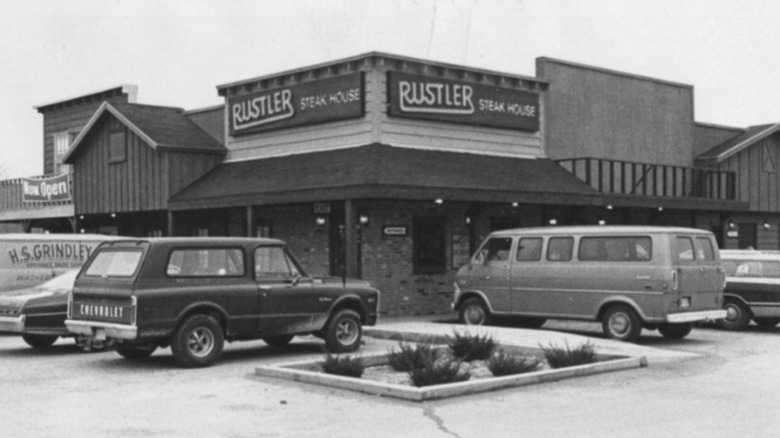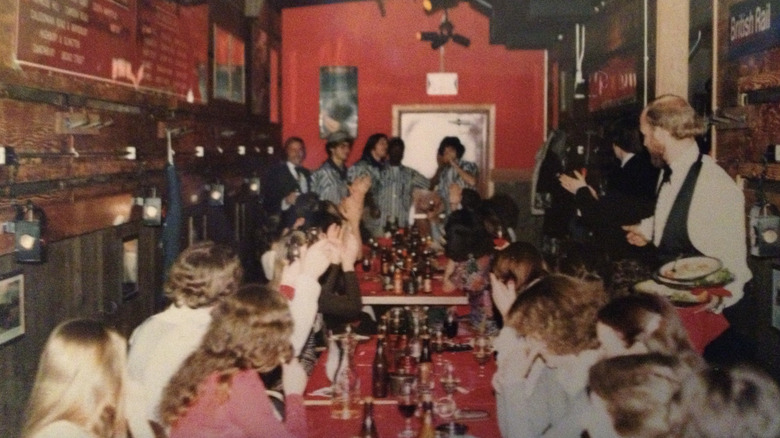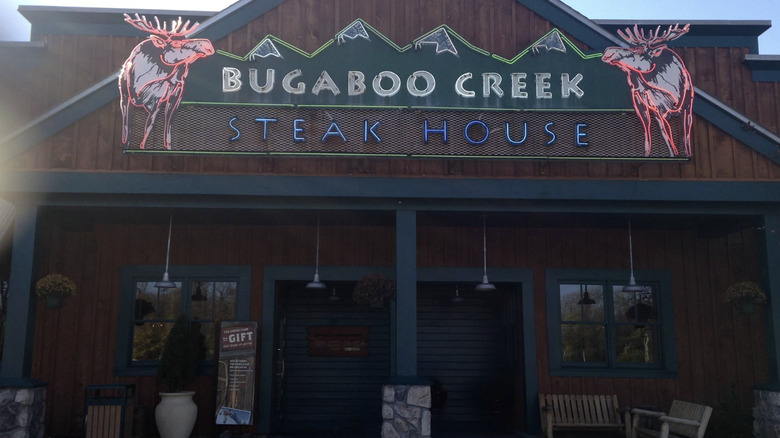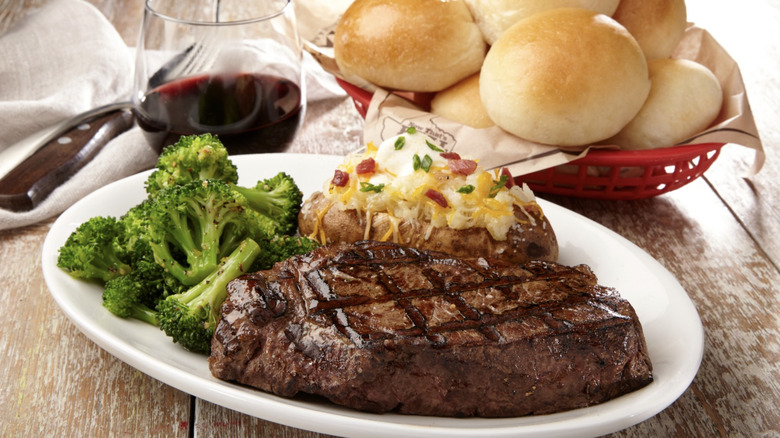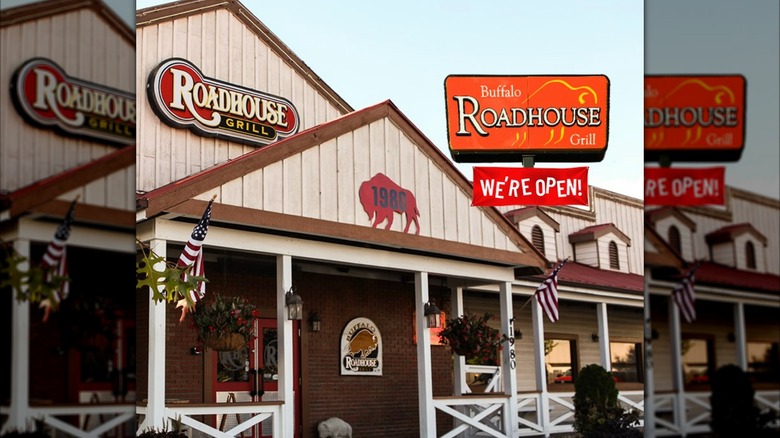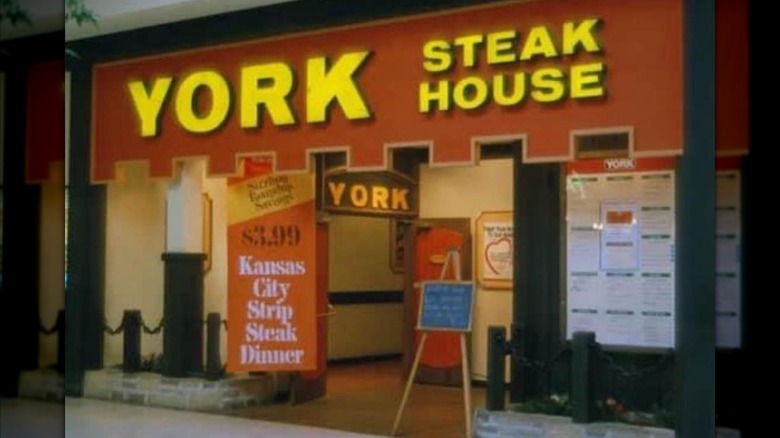Beloved Old-School American Steakhouses That Disappeared
Hearty, tender, and juicy, steaks hold a special place in American culinary heritage. Whether casual or fine dining, steakhouses play a huge part in linking today's diners to centuries of tradition. Modern steakhouses have a long history, dating back to 17th-century London, where chophouses served hearty cuts of beef to blue-collar workers. As immigrants arrived in America, they brought with them different culinary influences, giving rise to the emergence of steakhouses in the Meatpacking District of New York in the early 19th century.
Initially little more than taverns catering to laborers, it wasn't long before steakhouses began attracting more affluent diners. One of America's oldest steakhouses opened in 1868, setting a precedent for today's steakhouse scene. The Old Homestead in New York City, which still operates today, has been in the same location in the historic Meatpacking District since day one. While the Old Homestead continues to attract diners, not all steakhouses have been as successful. Many steak restaurants have come and gone, disappearing due to changing dining trends, rising costs, and increasing competition. Here is the story of the 12 old-school American steakhouses that have closed their doors forever.
Beefsteak Charlie's
The moniker Beefsteak Charlie's dates back to 1910, when an eatery by that name opened in Manhattan, becoming known for steak sandwiches and a racing-themed decor. The restaurant was a hangout for jazz artists before disappearing from New York's dining scene decades later. Much later, in 1976, Larry Ellman took the name Beefsteak Charlie's, which hadn't been trademarked, and used it to rebrand his Steak & Brew outlets, creating an entirely separate restaurant chain.
Beefsteak Charlie's was a buffet-style restaurant that opened with the following slogan made by Ellman: "I'll never serve a steak I wouldn't eat or charge a price I wouldn't pay." At the time, diners could order boneless sirloin for $4.99, old-fashioned beefsteak for $4.79, and filet mignon for $7.99. All dinner options came with a bottomless salad bar — that included such indulgent offerings as pre-peeled shrimp — as well as unlimited wine, beer, or refreshing sangria.
Beefsteak Charlie's experienced its heyday in the early '80s, expanding to 68 locations. However, this period of success wasn't meant to last, with the chain scaling back to 48 locations by 1987. The restaurant filed for bankruptcy in 1989, cutting operations even further. Undone by increasing competition and unprofitable offers, the Beefsteak Charlie's brand had disappeared entirely by the mid-2000s.
Valle's Steak House
Founded by Italian-American restaurateur Donald Valle in 1933, Valle's Steak House started out as a modest 12-seat cafe in Portland, Maine. Focusing on steak and lobster, the restaurant was an immediate success. It wasn't long before the operation expanded with another restaurant opening in Portland and new outlets in Maine. The operation continued to grow rapidly in the 1960s, expanding its outlets from Maine all the way to New York. At its peak, Valle's Steak House was serving over 200,000 customers weekly. At one stage, Valle's Steak House was even issuing its own credit cards.
Things started to go sour after Donald's passing in 1977. Rising gas prices and the subsequent economic downturn took their toll on the business, leading to multiple closures. The last Valle's Steak House shuttered in 1991. In an effort to keep her father's legacy alive, Donald's daughter acquired the former Valle's Steak House location on Brighton Avenue in Portland, keeping it open until 2000.
Hilltop Steak House
Today, all that remains of the once-popular Hilltop Steak House on Route 1 in Saugus, Massachusetts, are memories and a 68-foot high neon cactus sign. However, the fiberglass cows that once welcomed diners are nowhere to be found. In fact, two of the life-size cows were stolen by someone with an eye for quirky souvenirs when the restaurant closed its doors in 2013 — luckily, the police ended up apprehending the culprit and confiscating the bovines.
The Hilltop Steak House story began in 1961 when Frank Giuffrida invested $7,000 to transform the space into a 125-seat restaurant. In keeping with the Wild West theme, the steakhouse was decked out with totem poles, buffalo heads, and stone fireplaces. Given that Giuffrida was a butcher before venturing into the restaurant business, it was only apt that the steakhouse also featured its own butcher shop.
Over the years, Giuffrida expanded the steakhouse to accommodate 1,500 guests in a single seating. At the height of its success, the chain would serve 3 million customers annually. Hilltop Steak House shuttered after more than five decades in business due to a decline in the number of customers, as well as rising competition and operating costs.
Lone Star Steakhouse & Saloon
Established in Winston-Salem, North Carolina, in 1989, Lone Star Steakhouse & Saloon was a Western-themed restaurant chain that expanded across the country at a relatively fast pace. Known for its budget-friendly steaks, hearty ribs, and dipped sandwiches, the casual restaurant also offered buckets of free peanuts and treated diners to regular line dancing routines performed by the employees. And this business model worked.
The chain's golden era was to be short-lived. Despite acquisition by the Day Star Restaurant Group, the brand struggled to maintain momentum, shutting most of its U.S. locations by 2018. Increasing competition from similar steakhouse chains like Texas Roadhouse and declining food quality no doubt contributed to this rapid fall from grace. Interestingly, Lone Star Steakhouse & Saloon has one remaining location — but it's not in the U.S. The surviving restaurant sits many miles away in Tamuning, Guam, a nostalgic reminder of the once-thriving steakhouse chain.
BOCA Restobar & Grill
Located in Capitol Hill, Seattle, BOCA Restobar & Grill offered Argentine‑inspired cuisine. The restaurant was part of a small Seattle chain that included Boca Restaurant at Queen City Grill and Boca Argentine Bakery & Pizzeria. Offering a range of steaks, BOCA featured menu items such as Churrasco – Top Sirloin, Entrana – Skirt Steak, and Bife Gaucho – Ribeye. The restaurant, as well as its sister establishments, closed in mourning following the death of its founder Marco Casas Beaux in January 2024. While this closure was meant to be temporary, the restaurants never reopened.
It turned out that the business owed unpaid rent of over $65,000 and had outstanding tax liabilities amounting to thousands of dollars. This made it impossible for Marco's daughter, Andrea Casas-Beaux, to take over the business. The Beaux family explained the situation on a GoFundMe page at the time, noting that after Marco's passing, they had to make the difficult decision to close his Seattle restaurants. Because of legal issues outside of their control, they were unable to keep ownership and ultimately lost access to all BOCA assets.
Mr. Steak/Mr. Steak's Firegrill
Just like many other now-defunct American steakhouses, Mr. Steak's downfall was partly linked to the growing competition from other steakhouse chains, such as Bonanza, Ponderosa, and Sizzler. Established in 1962, at the height of its popularity, Mr. Steak boasted over 250 locations across the U.S., enjoying its greatest success in Mid-Michigan. The steakhouse began its downward spiral in the late '80s, with a Denver-based investment firm stepping in during the early '90s to rescue the chain from bankruptcy.
In 1993, the remaining Mr. Steak locations were rebranded as Mr. Steak's Firegrill, a restaurant chain that featured a "western nature" theme and an open kitchen. At the time, Jack Leone, director of concept development for Omnivest/Mr. Steak explained the ambitious concept to Nation's Restaurant News, saying, "The restaurant will have interior images of stones, the sky, a campfire. [...] The Firegrill building will have a vaulted ceiling, and the lighting pattern will be able to transform the interior from sunlight to sunset to give the appearance that you're eating outside under the stars." Despite the innovative concept, the revamp failed to spark a turnaround, with the last Mr. Steak Firegrill closing its doors in 2009.
Rustler Steak House
Over its two or so decades in business, Rustler Steak House changed hands on multiple occasions. Founded by a retired football pro, Joe Campanella, in 1963 or 1964 in Philadelphia, the restaurant had five locations when it was acquired by Gino's Inc. Throughout the years, Rustler Steak House was operated by Marriott, Tenly Enterprises, and finally Collins Foods, which purchased the remaining restaurants in 1985, gradually converting them to Sizzler Steakhouses.
Before it was rebranded by Tenly Enterprises, Rustler Steak House was a Western-themed restaurant, complete with "cowpoke commercials." Perhaps Tenly's chairman at the time, James M. Sullivan, summed up the chain's advertising campaign best in a 1984 interview with the Washington Post, saying, "Can you imagine seeing these cowboys with these dirty clothes and missing teeth and wanting to dine in that restaurant?" Despite Tenly's efforts to "de-Westernize" the chain and broaden its menu, Rustler never quite managed to reinvent itself, ultimately closing its doors for good.
Victoria Station
The Victoria Station steakhouse hedged its bets on a novel concept. Opened in 1969 in San Francisco, California, the first Victoria Station restaurant was situated in old railroad boxcars and cabooses. The decor was completed by old railroad memorabilia. As the chain expanded, the same railroad motif was replicated at other locations. During its initial years in business, Victoria Station was an undisputed success, expanding its reach to nearly 100 locations by 1978. Interestingly, in 1975, Johnny Cash collaborated with the chain, releasing an album titled "Destination Victoria Station," which featured railroad-themed songs.
The chain started experiencing financial difficulties in the early 1980s, posting a deficit of $6.3 million in 1981. There are several reasons for this failure, including overexpansion, rising beef prices, and the fact that customers got bored with the restaurant's somewhat gimmicky concept. Attempts at diversification, such as the failed Bonkers gourmet burger restaurants, only depleted the business' finances further. In 1986, Victoria Station filed for Chapter 11 bankruptcy. While the restaurant lived on for the next few decades, the last Victoria Station location in Salem, Massachusetts, closed its doors in 2017.
Bugaboo Creek Steakhouse
Founded in Warwick, Rhode Island, in 1993, Bugaboo Creek Steakhouse was a Canadian-themed restaurant that's probably better remembered for its animatronics than its food. These included mounted deer, bear, and moose heads, some of which were designed to tell diners about Canadian history and natural highlights.
Perhaps unsurprisingly, Bugaboo's interactive environment and menu of mediocre dishes weren't enough to keep the chain running. After 17 years in business, Bugaboo Creek filed for Chapter 11 bankruptcy in 2010. Just a year later, the chain was acquired by Capitol BC Restaurants LLC, which took over its remaining 12 locations in Delaware, Maine, Maryland, Massachusetts, New Hampshire, and New York. The company made efforts to revolutionize the Bugaboo brand, giving the chain a new decor and menu. Bugaboo's marketing campaign was also revamped to modernize the restaurant's dated image. Despite these valiant efforts, the last Bugaboo Creek location closed around 2016.
Sagebrush Steakhouse
First opened in Hickory, North Carolina, in 1990, Sagebrush Steakhouse once operated over 20 restaurants in North Carolina, South Carolina, Tennessee, and Virginia. The Western-themed, casual dining restaurant featured Southern and Hollywood-inspired knick-knacks. Aside from steaks, Sagebrush served seafood, chicken, and salad dishes. As of 2025, only one Sagebrush Steakhouse location remains, in Dunn, North Carolina. However, rather than being an independent establishment, the restaurant operates under the umbrella of the Texas Steakhouse & Saloon.
While not a lot of information exists about Sagebrush's demise, we do know that the chain closed some of its locations rather abruptly. For instance, when the Colonial Heights, Virginia, Sagebrush location closed in 2016, employees were caught completely by surprise. The restaurant's general manager, Mary Caster, explained the situation to WTVR‑TV at the time, saying, "My assistant manager called me Monday and told me our doors were shut. [...] Some people actually went to work [on Monday] and there was a note on the door."
Roadhouse Grill/Buffalo Roadhouse Grill
Roadhouse Grill was the brainchild of industry veterans John Y. Brown, a former chairman of Kentucky Fried Chicken and founder of Kenny Rogers Roasters, and J. David Toóle III, who previously worked as a regional supervisor for Ryan's Family Steak House and helped develop Logan's Roadhouse. Established in 1993 in Pembroke Pines, Florida, Roadhouse Grill featured a rowdy, country vibe, appealing to casual diners. The restaurant's concept emphasized entertainment as much as dining, with loud music and barrels of peanuts and plenty of shell tossing on the floor. In addition, the restaurant's multilevel seating offered diners views of the mesquite grill where the steaks were prepared.
The restaurant took a rather aggressive expansion approach, opening six locations in its first year of operation and 16 in the second year. By 1997, Roadhouse Grill had grown to 40 locations. At its height, the chain boasted approximately 85 restaurants. This rapid development led to large debts, with the company filing for bankruptcy in 2002 after rent defaults and declining sales. Despite a brief recovery, declining dining traffic after 9/11 and hurricane-related losses in Florida resulted in the company filing for bankruptcy in 2007 and closing its remaining 20 locations in 2008.
Just a year later, in 2009, three former Roadhouse Grill employees opened Buffalo Roadhouse Grill in a shuttered Roadhouse Grill site located in Tonawanda, New York. The restaurant's menu retained some Roadhouse Grill dishes, serving them alongside Buffalo specialties. Buffalo Roadhouse Grill closed in 2020, blaming financial losses caused by COVID-19 restrictions.
York Steak House
Founded in 1966 in Columbus, Ohio, York Steak House quickly became a mall staple, growing to around 180 locations in some 10 years. Most of these restaurants closed over the next few decades — in fact, only one York Steak House remains in operation today, still serving buffet-style fare in its hometown of Columbus. The main reason for the chain's decline was the growing popularity of mall food courts, which drew customers away from the establishments.
The last York Steak House was put up for sale in 2024 after its longtime owner announced plans to retire after decades at the helm. The restaurant was acquired by the Starliner Diner, which assured customers that it would not be making any major changes to the steakhouse. The new ownership also promised that it would retain both the restaurant's menu and its overall concept.
York Steak House still serves a lot of the original menu items from when it first opened in the 1960s, including sirloin tips, twin filets, fried shrimp, honey-glazed chicken, and chocolate pudding. Notably, the restaurant's former owner, Jay Bettin, explained the restaurant's appeal, saying, "They walk in the front door and feel like they're back in 1970. People make road trips here. They come from miles and stop by just so they can relive some of those memories and say they ate at the last York Steak House standing" (via Cleveland.com).
